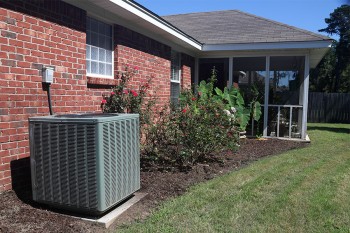A Thoughtful Approach to Keeping Lines Clear
Right-of-way management is incredibly valuable for reliability and cost savings at your electric co-op
By Doug JohnsonBlue Ridge Energy uses aerial tree pruning, a safe and environmentally friendly vegetation management practice. With this method, helicopter pilots carefully conduct pruning along rights of ways. Trained employee “spotters” located on ground level of the right of way are in constant communication with the pilot.

Electric cooperatives across North Carolina are making investments in technology to create a more flexible grid, improving reliability and ultimately lowering costs. But there’s also a tried-and-true, decidedly low-tech way to help keep the lights on when bad weather strikes: tree trimming and vegetation management.
North Carolina is blessed with large swaths of forests, which serve as valuable wildlife habitat and create recreational havens to escape the bustle of day-to-day life. But following heavy rains, winds or ice storms, more woodlands means more downed limbs and toppled trees. If powerlines are between them and the ground, a power outage is often the result.
That’s why right-of-way management is so incredibly valuable for reliability and cost savings overall at your electric co-op. Clear rights-of-way enable our line crews to work safely and help them get the power back on faster should an outage occur. We take it seriously through a thoughtful approach, which keeps the health of surrounding vegetation and wildlife in mind.
A right-of-way (sometimes abbreviated “ROW”) is a path on which poles and wires are placed. These corridors can range from 30 feet wide (15 feet on each side of the power line) for distribution power lines to as much as 250 feet wide for large transmission lines.
Electric co-ops manage rights-of-way using a variety of methods. Some co-ops use their own crews to do the work, and some use contract crews that specialize in vegetation management. Overhanging branches are trimmed using bucket trucks, and in some instances, by helicopter. Although you may occasionally see shorter trees “topped” to avoid an overhead power line, that’s only a temporary solution and not a professionally recognized method of pruning. It can promote stress, disease, insects and weak branch attachments in trees, so the preferred method in these cases is full removal.
Herbicides can also be used, which is cost effective and less invasive than mechanical trimming. It is selectively applied to tall woody species, leaving behind weeds and grasses that will not interfere with lines. Blue Ridge Energy uses an herbicide that doesn’t stay active in soil and only affects the plant it is applied to by entering through the leaves.
Electric co-ops work with our members to keeps rights-of-way maintained while promoting healthy surrounding vegetation.
Tree removal for ROW management purposes has a side benefit of promoting the growth of native weeds and grasses, which can be beneficial to pollinators like bees and butterflies, and serve as a food source and habitat for wildlife. The North Carolina Electric Membership Corporation has joined the state’s “Butterfly Highway” by seeding wildflowers near its Hamlet power plant; and other electric co-ops around the state, including Blue Ridge Energy, are working on their own pollinator habitats.
Electric co-ops work with our members to keeps rights-of-way maintained while promoting healthy surrounding vegetation. There are several ways you can help:
- If planting a tree near utility equipment, pick a spot far enough away from overhead lines so that the tree won’t grow to become an issue. A safe distance is typically 30 feet away from lines for medium trees (25–40 feet tall at maturity) and at least 50 feet away for large trees (taller than 40 feet at maturity).
- Smaller trees and shrubs can be planted adjacent to power lines, but consult your electric co-op for a recommended list of options.
- Plant with pollinators in mind, using flowering native plants when possible.
- Always call 811 before a digging project on your property to ensure you avoid buried utility lines.
- If you see a diseased, damaged or weak tree near a power line, report it to your electric cooperative so it can be assessed and, if need be, removed.
The next time you pass a section of power lines running through a wooded area, take a closer look. Are there any limbs overhanging the lines? Are any tree canopies growing up to touch the poles or wires? The answer is very likely no — due to diligent ROW management — and if yes, it likely won’t stay that way for long.
About the Author
Doug Johnson is CEO for Blue Ridge Energy in Lenoir.-
More Viewpoints
-
Share this story:






